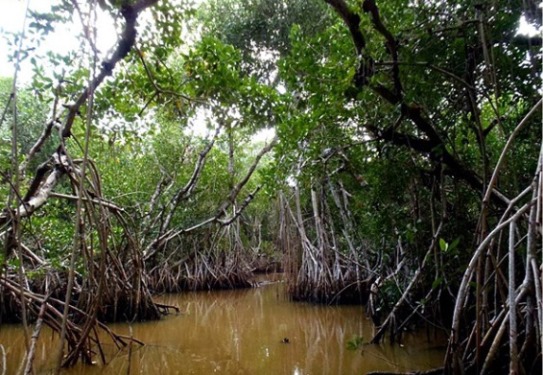Mangrove forests are taxonomically diverse assemblages of trees and shrubs that form the dominant plant communities in tidal, saline wetlands along sheltered tropical and subtropical coasts. They have several ecological and physical functions that are essential in maintaining biodiversity and protecting populations of humans and animals. One of the most important functions is to provide a barrier or buffer between the land and the sea, with mangroves protecting landward coastal zones against potentially devastating ocean events, including tsunamis. See also: Biodiversity; Biogeography; Coastal landforms; Ecological communities; Ecosystem; Mangrove; Wetlands

Tsunamis are long waves generated by major geologic events, including underwater earthquakes, landslides, and volcanic eruptions, which rapidly flood adjacent and distant coastlines and coastal communities. Such floods typically have devastating impacts on both land and human-made structures. Mangroves have adapted to their intertidal environments and are able to withstand furious high-energy tidal events. For example, certain mangrove species can block or buffer wave action via their stems and aerial roots, which can measure 30 m (98 ft) in height. However, the elimination of many mangrove habitats, predominantly by human activities (for example, deforestation, land reclamation for tourist enterprises, and fragmentation caused by urbanization), has created a scenario in which coastal areas (particularly in Southeast Asia) are more vulnerable to the destructive effects of a tsunami event. See also: Deforestation; Earthquake; Ocean waves; Root (botany); Tsunami
Unfortunately, the role of mangroves as living barriers has not always been appreciated, and many mangrove forests have fallen prey to developers without regard to the environmental effects. For example, studies analyzing the effects of tsunamis on shoreline areas have determined that mangroves suffering from various types of ecological degradation were less resistant than unaltered pristine mangroves. One study was conducted in the aftermath of the massive 2004 Indian Ocean earthquake and tsunami that devastated huge areas in Indonesia, Thailand, Sri Lanka, and India, as well as killing more than 230,000 people. Researchers in the Andaman Islands in the Indian Ocean found a remarkable situation: In areas that had pristine mangrove forests, only 7% of the villages hit by the tsunami were severely damaged; in contrast, in areas with mangrove degradation or elimination (chiefly as the result of development by tourist industries or aquaculture companies), the devastation of villages reached 80–100%. Other investigations of smaller tsunami events since 2004 have reached similar conclusions. Thus, the preservation and recolonization of mangrove forests are necessary steps to ensure the barrier protection afforded by these strategic greenbelts against tsunami events. See also: Coastal engineering; Conservation of resources; Indian Ocean; Sumatra-Andaman earthquake





